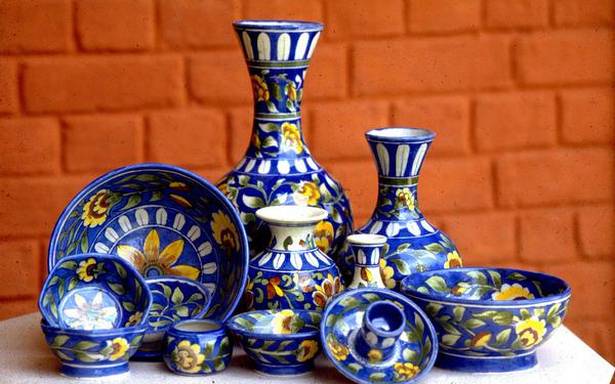By upcycling ceramic waste, interdisciplinary designer Disharee Mathur reinvents the heritage craft of Jaipur Blue Pottery at the ongoing, digital graduate show ‘RCA2021’
Imagine innovative cooling tiles made from the striking Jaipur Blue Pottery? Or furniture and modern lighting created using ceramic waste?
Disharee Mathur’s Project Newblue is reinventing the century old-craft of Jaipur Blue Pottery with rejected ceramic waste. Disharee, an interdisciplinary designer from Jaipur, describes Project NewBlue as a conversation between “an Indian craft community, material science and design”.
Interdisciplinary designer ,Disharee Mathur revamped the century old-craft of Jaipur Blue Pottery with rejected ceramic waste
The young designer took material innovation in Blue Pottery as her graduating project for her Master’s in Innovative Design Engineering at the Royal College of Art and Imperial College, London, during the pandemic. “Jaipur Blue Pottery is one of the few pottery techniques in the world that does not use clay; it is versatile in its ability to take shape using traditional moulds. The material is good to make souvenirs but lacks strength, which limits its applications.”
A handful of artisans
Disharee, who works across interior, interaction and product design, collaborated with the artisans and on the material to understand its limitations and the current plight of the craft. “India, which has the largest craft concentration in the world, has only 2% of the global handicraft market share (Business Economic 2020). There are less than 300 artisans working with the craft and I believe design engineering could help widen the scope.”
Read More | Traditional pottery returns to Thottakam, Kerala
She began working with Neerja Blue Pottery in Jaipur. “I found huge amounts of rejected sinks and toilets lying around the city,” she recalls. “The government was looking for new land to dump this non-biodegradable waste.”
History and how-to’s
- Jaipur Blue Pottery, which was conferred Geographical Index Status (GIS) in 2008, travelled from Iran and Turkey to India in the 14th century. Used primarily for souvenirs or decorative tableware such as coasters, vases, trays, plates and doorknobs, its applications have remained limited since the 1850s when it was patronised by the ruling house of Jaipur. A century later, the dying craft and was revived by the royal family and patrons of art and culture. In 2005, the Central Glass and Ceramic Institute of India (CGCII) introduced a new glaze finish.
- Jaipur Blue Pottery is one of the few pottery techniques in the world that does not use clay. Locally-sourced quartz powder, recycled glass, plant-based gum (katera), and Multani Mitti are ground together and kneaded to make a dough. This is then moulded like a flatbread, sun dried, and finished with intricate motifs done with oxide pigments, as an underglaze. The glaze is applied as the last step before firing at around 800 degrees.
With sustainability at the core of her practice, Disharee connected with Dr. Himmat Singh Kushwaha of the Material Research Centre at the Malviya National Institute of Technology and pitched the idea of using sanitaryware waste to strengthen blue pottery material.
Upcycling ceramic waste
The two began experimenting by adding small quantities of rejected and broken pieces of sinks and toiletware. “The process after addition of sanitary ware remains exactly the same as with Jaipur Blue Pottery. It is added the same way recycled glass is, which is broken and ground on site using the machinery in the craft workshops. I was guided by the experiments and feedback from the artisans. It was a huge learning,” she says.
As the pottery mix already uses recycled glass, adding another recycled ingredient felt not too far from tradition. The challenge was to see if the different colours and glaze would be accepted aesthetically after addition of this sanitaryware waste. She found that the new material doubled in strength and that there was no difference visually with colour.
New application
To diversify the product range of the craft, Disharee collaborated with architect and founder of Industhan Ceramics, Pranav Gajjar. “Industhan’s passive cooling tiles, which are used as building facade tiles, as extra thermal layer, seemed to be a perfect opportunity to explore new uses of the NewBlue material. It juxtaposes two cultural technologies,” she says.
She calls the two aspects to her innovations ‘A Synonym and Antonym for Jaipur Blue Pottery’. The former refers to a stronger material that is synonymous with traditional JBP while the latter deletes the toxic glaze to allow for moisture absorption for new applications like passive cooling.
“It is a new product and I understand the first installation is underway,” she says, hopeful that this will open a host of new possibilities for the traditional ceramic.
The NewBlue project can be accessed at https://2021rca.ac.uk/
Source: Read Full Article


